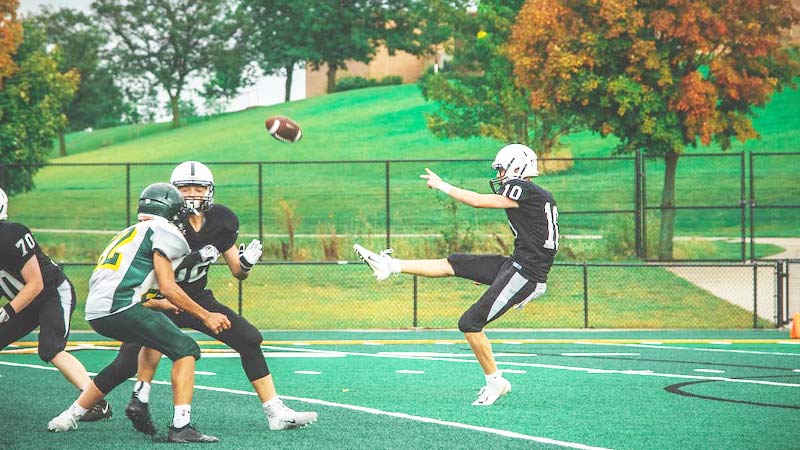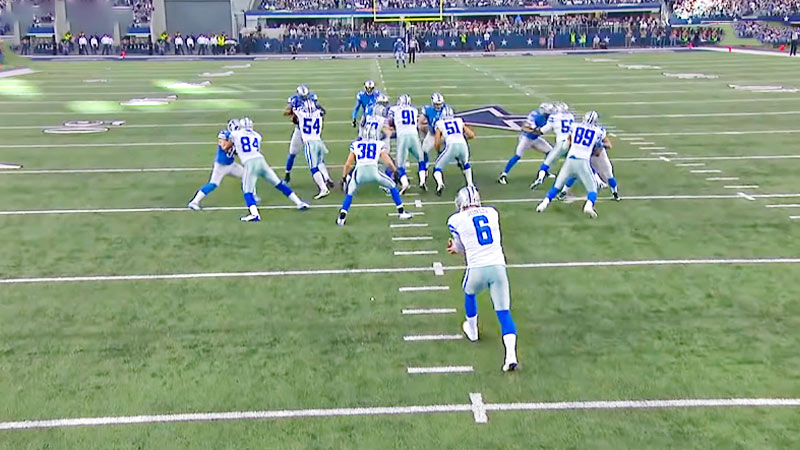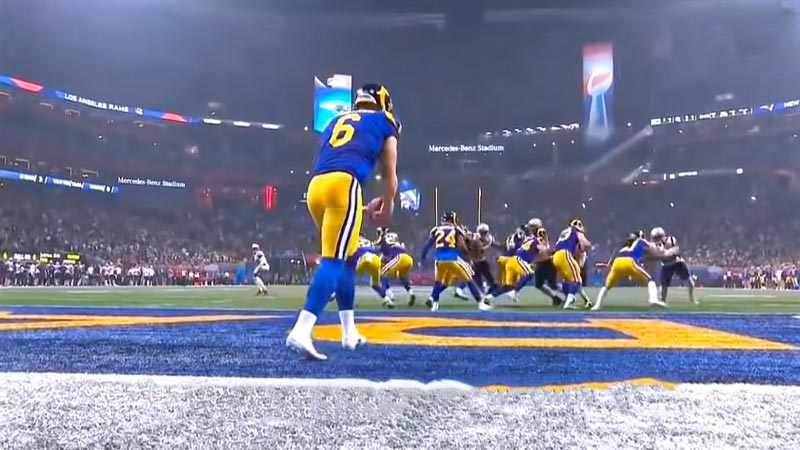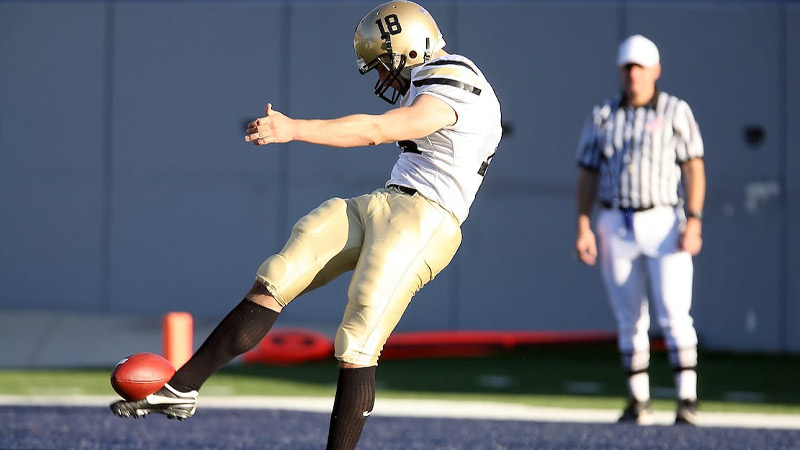In the world of American football, strategies and tactics are as diverse as the players themselves. From complex offensive plays to hard-hitting defensive maneuvers, every aspect of the game contributes to the thrill and excitement that fans love.
One such strategic move that often goes unnoticed by casual spectators is the “coffin kick.” This specialized kicking technique holds immense importance in shaping the field position battle, affecting game momentum, and showcasing the intricacies of the sport.
In this blog post, we’ll delve into the details of what a coffin kick is, how it’s executed, and its significance in modern football. So, stay focused.
What Is A Coffin Kick In Football?
In American football, a “coffin kick” typically refers to a punting strategy aimed at pinning the opposing team deep into their own territory. The term “coffin corner” refers to the narrow area of the field near the end zone where the goal line and the sideline intersect.
A perfect coffin corner kick is a well-placed punt that goes out of bounds near this area, making it difficult for the receiving team to advance the ball and increasing the likelihood of a touchback.
The coffin corner kick requires precision from the punter to accurately place the ball close to the sideline while avoiding it going into the end zone.
By doing so, the kicking team reduces the available space for the receiving team to operate, forcing them to start their offensive drive from a less advantageous field position.
This strategy is particularly effective when a team is close to their opponent’s end zone and wants to prevent the opposing offense from gaining significant yardage on the ensuing drive.
History of Coffin Kick-In Football

The history of the coffin kick, also known as the coffin corner kick, in American football, traces back to the evolution of the sport’s kicking strategies and tactics. Here’s a brief overview of its history:
Early Years of American Football
In the early days of American football, kicking was an integral part of the game. Punting was used to exchange field position, and teams sought ways to pin their opponents deep into their own territory.
Introduction of Specialized Punting
As the sport progressed, teams started to employ specialized punters who could execute accurate and strategic kicks. This led to the development of punting strategies that aimed to limit the return yardage for the opposing team.
Pioneering the Coffin Corner Kick
The term “coffin corner” likely originates from the idea that a perfectly placed punt would “bury” the opposing team deep in their own territory, much like placing a body in a coffin.
The strategy involves punting the ball toward the corner of the field near the end zone and the sideline, making it difficult for the returner to gain significant yardage.
Precision and Execution
The coffin corner kick requires exceptional precision and timing. Punters need to accurately judge the flight of the ball, the wind conditions, and the positioning of the returner to place the ball near the sideline while avoiding it going into the end zone.
Over time, punting techniques improved, allowing punters to increase their accuracy and control.
Strategic Impact
A well-executed coffin corner kick forces the receiving team to start their offensive possession deep in their own territory, significantly reducing their potential for a successful drive.
This defensive advantage makes the coffin corner kick an essential tool for field position battles in football.
Continued Evolution
As the sport evolved, teams and coaches continued to refine their special teams strategies. While the core concept of the coffin corner kick remains consistent, new techniques, training methods, and equipment have contributed to the ongoing improvement of punting skills.
Implementation of Coffin Kick In Modern Football

The implementation of the coffin kick in modern American football remains a crucial aspect of special teams’ strategy.
While the core concept of pinning the opposing team deep in their own territory has remained consistent, advancements in technique, analytics, and coaching methods have influenced how the coffin kick is executed in today’s game. Here’s how the coffin kick is implemented in modern football:
Player Specialization
Many football teams have specialized punters who focus solely on punting duties. These punters possess the skill and experience needed to execute precise kicks, including coffin corner kicks.
Punting Technique
Modern punters have refined their techniques, including factors like foot placement, ball drop, and follow-through. Proper technique allows for better control over the trajectory and direction of the punt.
Field Position Awareness
Punters and coaches utilize advanced analytics and data to assess field positions and make informed decisions. This includes understanding wind conditions, evaluating the distance needed for an effective coffin corner kick, and identifying optimal angles for placement.
Punt Coverage
The kicking team’s coverage unit plays a vital role in the success of a coffin corner kick. Players must sprint down the field to down the ball near the sideline before it goes into the end zone.
Effective coverage prevents touchbacks and forces the receiving team to start their drive from a less favorable position.
Coordination with the Return Team
Coaches work with punters to communicate their intended direction and placement for the kick. This coordination helps the return team set up for the best possible outcome, whether it’s downing the ball, forcing a fair catch, or preventing a long return.
Adapting to Rule Changes
Over time, rule changes have impacted special teams’ play, including kickoffs and punts. Punters and coaches need to adapt their strategies to align with new rules while maintaining the effectiveness of coffin corner kicks.
Game Situation and Strategy
The decision to employ a coffin corner kick depends on various factors, such as the score, time remaining in the game, field position, and the strength of the opposing returner. Coaches make strategic choices based on these factors to maximize their team’s advantage.
Practice and Repetition
Like any skill in football, executing coffin corner kicks requires consistent practice and repetition. Punters spend countless hours refining their craft through practice drills, simulated game scenarios, and real-game experiences.
Innovations in Equipment
Technological advancements in equipment, such as improved footballs and punting boots, can influence the flight and accuracy of the punt, affecting the execution of coffin corner kicks.
Purposes of Coffin Kick

The coffin kick, also known as the coffin corner kick, serves several strategic purposes in American football:
Field Position Battle
One of the primary purposes of the coffin kick is to influence the field position battle. By placing the ball near the sideline and deep in the opponent’s territory, the kicking team aims to force the opposing offense to start their possession from a position that is farther away from their end zone.
This can make it more challenging for the offense to drive down the field and score points.
Pinning the Opponent
The coffin kick is designed to “pin” the opposing team close to their own end zone. When executed effectively, the receiving team is forced to start their drive deep within their territory, limiting their options and making it more difficult for them to gain yardage.
Reducing Return Opportunities
A well-placed coffin kick reduces the likelihood of a significant return by the receiving team. The ball is strategically placed to minimize the returner’s ability to gain yardage and potentially break away for a long return.
Creating Defensive Advantage
By placing the ball near the sideline and deep in the opponent’s territory, the kicking team puts the opposing offense in a less advantageous situation. The confined space near the sideline limits the offensive playbook and makes it harder for the offense to execute plays effectively.
Limiting Scoring Opportunities
Placing the opponent deep in their own territory through a coffin corner kick can limit their scoring opportunities. Teams are less likely to attempt riskier plays near their own end zone due to the increased potential for turnovers or safety points for the defense.
Flipping Field Position
The coffin kick can be used as a tool to flip the field position in favor of the kicking team.
If executed successfully, the receiving team has a longer distance to cover to reach the kicking team’s end zone, giving the kicking team’s defense a better chance to make a stop and regain possession with a better field position.
Time Management
In situations where time is a factor, such as near the end of a half or game, a coffin corner kick can eat up valuable seconds as the opposing team retrieves the ball and starts their drive from a deeper position.
Psychological Impact
Successfully executing a coffin corner kick can have a psychological impact on the receiving team. Starting a drive from deep within their own territory can create a sense of pressure and urgency for the offense, potentially leading to mistakes or conservative play-calling.
Strategic Playcalling
The presence of a well-executed coffin corner kick in a team’s arsenal can influence the strategic decisions of both teams. Coaches may make different play-calling decisions based on the field position and potential outcomes of a drive.
Impact of Coffin Kick

The coffin kick, when executed effectively, can have a significant impact on the outcome of an American football game.
Its influence extends to various aspects of the game and can shape the strategies employed by both teams. Here are some of the key impacts of a successful coffin kick:
Field Position Advantage
The most immediate impact of a well-placed coffin kick is the field position advantage it provides to the kicking team.
By forcing the opposing offense to start their possession deep in their own territory, the kicking team gains a defensive advantage and increases the distance the opposing team needs to cover to score.
Defensive Pressure
Starting a drive near their own end zone puts additional pressure on the opposing offense. The confined space and limited playbook options can lead to conservative play-calling, reducing the chances of big plays and forcing the offense to execute a longer drive.
Reduced Scoring Potential
A successful coffin kick can limit the opposing team’s scoring potential. The deeper starting position makes it more difficult for them to quickly move down the field and score points, increasing the likelihood of punting or turning the ball over.
Strategic Decision-Making
The impact of a coffin kick influences the strategic decisions made by both teams. The receiving team’s coaches must decide whether to play conservatively to avoid turnovers or take calculated risks to advance the ball.
The kicking team’s coaches might adjust their defensive formations and play calls based on the opponent’s starting field position.
Time Management
A coffin kick can impact the amount of time an opposing offense has to work with. If executed late in a half or game, the receiving team may have limited time to orchestrate a successful drive, potentially affecting their play-calling and decision-making.
Special Teams Momentum
A successful coffin kick can shift momentum in favor of the kicking team. The special team plays, including well-executed coffin kicks, can energize the kicking team’s players and fans while deflating the confidence of the receiving team.
Field Goals and Touchbacks
A coffin kick that is downed near the goal line increases the likelihood of the receiving team starting their drive close to their own end zone.
This can affect the opposing team’s decision-making regarding field goal attempts and touchbacks, as they may be more hesitant to take risks deep in their own territory.
Statistical Impact
Effective use of coffin kicks can result in statistical advantages. A team that consistently pins opponents deep in their territory can force them into more punting situations, leading to a better average starting field position for the kicking team.
Game Momentum and Shifting
A coffin kick that pins the opponent near their own end zone can change the complexion of the game. It can lead to turnovers, defensive stops, or even safety points for the kicking team, causing a shift in momentum and influencing the overall flow of the game.
FAQs
What exactly is a coffin kick in football?
A coffin kick is a punting strategy used in American football to pin the opposing team deep into their own territory. The kicker aims to place the ball near the sideline and close to the opponent’s end zone, making it challenging for the receiving team to gain yardage on their subsequent drive.
Why is it called a “coffin kick”?
The term “coffin corner” refers to the narrow area of the field just in front of the end zone and near the sideline. The idea behind a coffin kick is to metaphorically “bury” the opposing team close to their own goal line, much like placing something in a coffin.
What’s the significance of a coffin kick in a game?
Executing a coffin kick successfully can have a profound impact on the game. It gives the kicking team a field position advantage, places pressure on the opposing offense to execute a longer drive, and limits the scoring opportunities of the receiving team.
How is a coffin kick executed?
A coffin kick requires precision and technique. The punter aims to kick the ball in a way that it lands near the sideline and close to the opponent’s end zone.
The goal is to have the ball go out of bounds just before reaching the end zone, preventing touchbacks and forcing the receiving team to start their possession deep in their own territory.
What factors influence the success of a coffin kick?
Several factors come into play, including wind conditions, the punter’s accuracy, the positioning of the returner, and the angle of the kick. The punter’s skill in judging these factors contributes to the effectiveness of the coffin kick.
Wrapping Up
In the fast-paced world of American football, even the seemingly straightforward act of punting can have a profound impact on the course of a game. The coffin kick stands as a testament to the strategic depth and complexity of the sport.
From its historical roots to its modern-day implementation, the coffin kick showcases the dedication of players, coaches, and teams to mastering the nuances of the game.
By understanding this specialized technique, fans can gain a deeper appreciation for the strategic intricacies that shape each football match. Best wishes.







